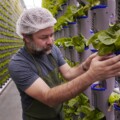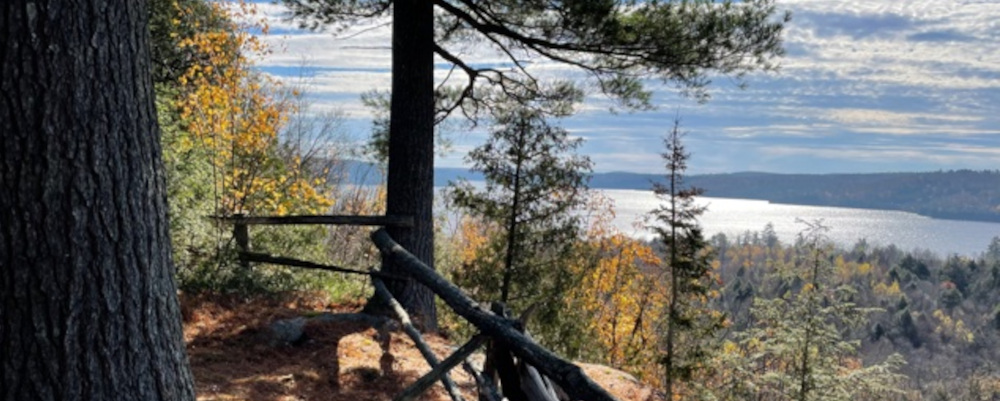I am standing on a promontory, one of several high points in Haliburton Forest. I can see for miles in three directions. The sky is a crystal light blue, streaked with horizontal clouds that resemble strands of white cotton candy. There are numerous freshwater lakes visible in the distance below me, each one a darker shade of blue than the sky above.
Then there is the thick forest that drapes the landscape as far as the eye can see. It is decked out in an array of fall colours, red, green, orange, shades of brown mottled by black shadows where the density of the trees prevents the sun from completely shining through.
This is what geographers call “The Algonquin Dome”, a land area that rises from 350m in the southwest to 580m to the northeast. It almost has an Appalachian feel to it, minus the villages and towns. It is actually the highest point of land in SE Ontario with its ubiquitous strands of maple/beech on its ridges, hemlock/yellow birch on north-facing slopes, white pine/red oak on cliffs and hilltops, and the lower shorelines which attract cedar and hemlock.
The area has been sculpted by a higher power that has created marshes, rivers, and lakes, and although the environment is a product of the melting of the ice of just 12,000 years ago, some of its rocks that comprise the Canadian shield range back a mere three billion years.
I cannot see any cottages or towns on the lake shores. It is as if the hand of man has never touched this landscape and I am seeing it through the eyes of the first French missionaries and trappers, who passed this way centuries ago.
These are the kinds of landscapes that over one hundred years ago, the painter Tom Thomson of Algonquin Park and Group of Seven fame witnessed, before he and his partners managed to express on canvas the great Canadian North, creating a new visual language that was foreign to European landscape traditions, but ideal for a unique wilderness in need of new evocations.
I mentioned this to Tegan Legge, a young and articulate official spokesperson for the Haliburton Forest who was taking my wife Mira and me on a tour of the forest. She said, “What you are seeing is not a pristine landscape, although it looks like one. It is a managed landscape and not much different than what you experience next door in Algonquin Park. Even Tom Thomson did not see what the French trappers must have seen because this area (Haliburton Forest and adjacent Algonquin Park) was logged from the late 19th through to the early 20th century. It is still being logged. The only difference is that today our logging operations are scientific, economical, sustainable, and even aesthetic as we are trying to mirror nature and work with her. But it is a managed environment.”
“You could have fooled me!” I thought to myself as we moved down the hill from the high point.
Haliburton Forest is not a charity. It is not an NGO. It is a private conservation area, a managed wildlife, forestry, hiking, and canoeing centre, open to the public and paid visitors, as is next door government-run Algonquin Park, also open to a public who pays for the right to camp and canoe within its boundaries. The difference is that Haliburton Forest is privately owned. Yet it is up to date, professionally managed, FSC approved, and the winner of numerous conservation and biodiversity awards.
The 100,000 acres of forest, lake, river, and wildlife that comprise today’s Haliburton Forest is about the size of Bermuda. It was logged extensively during the 19th century and 20th centuries. Much of this lumber went south along the rivers and then along the industrial train routes, some of which still exist but most of which have been converted into beautiful hiking trails, like the one between Fenelon Falls and Lindsay town south of here in the Kawarthas.
After WWII what is today Haliburton Forest was purchased by a group of German immigrants from a German aristocrat Baron Fuerstenberg. In the eyes of the new owners they saw what could become, “a managed, multi-use forest, a for-profit business, committed to forest stewardship, in perpetuity.” This did not surprise me.
It was the Bulgarian-born Nobel Prize Winner Elias Canetti who once wrote, “The Englishman likes to imagine himself at sea, the German in a forest.” Whereas in Germany there is no real wilderness, in the New World there is, and so these Europeans came here to develop a new form of participatory forestry in the “new world” of post-WWII Canada. What does it comprise?
Adam Gorgolewski is a young British-born forestry scientist, another but different kind of European, in love with Canada’s North. He holds a Ph.D. in forestry from the University of Toronto.
He tells us, “I used to come here for research as often as possible, but in the back of my mind I always wanted to be here full time. And now here I am.” He told us much about the forest and the research that supports forestry but prefaced his introduction with the following caveat, “Haliburton Forest is one of the best-researched sites in Ontario. On a per-acre basis, there has been more research done here than in neighbouring Algonquin Park. We have so many research partners and there is a wealth of scientific literature on the place for those who care to read it. But you have to remember, modern, scientific, and ecologically informed forestry is less than one hundred years old, and we do not have a lot of long-term monitoring data. There is so much we do not know. Evolution is constantly surprising us.”
I asked him for an example that is clear to the layperson. He responded, “In the near future there will be no beech trees in this entire region. They are all dying off. We have no cure for the disease that is systematically killing off this species. And so today, our forestry and sawmill activities are adjusting to this. We are harvesting as many beech trees as we can. We use them for all kinds of purposes including railway ties. But one day they will no longer be here. As a scientist, I remind visitors that evolution has not stopped. There is no steady-state here, no perfect conservation idyll which in romantic terms we hold to in the face of southern encroachment, roads, cities, and the like. Nature is complex. We try and understand it and adapt.”
One of my more cynical colleagues, a left-leaning filmmaker who accompanied me on a field trip to the forests of the Congo once said, “The problem of Ontario is that the north is just one big industrial park that feeds southern Ontario.” With its minerals, forests, wildlife and hydro there is something to be said for this point of view. But Haliburton Forest suggests there may be other ways to do conservation and provide local, well-paid employment.
The company includes some of the following profitable activities; fishing, hunting blocs, a wolf conservation centre with its own pack, an astronomical observatory, natural forests, sawmills, a restaurant, custom made educational and recreational tours, the renting out of campsites, canoeing and kayaking, all-season hiking, and snowmobiling in winter, not to mention a sustainable housing unit (Ecolog |Homes), and of course the Paddle Shop.
The Paddle Shop is near one of the sawmills run by the company. We met its master craftsman, a young man named Corey Pietryszyn, an avid paddler and canoeist who like so many of the other young employees is a graduate of Fleming College in nearby Haliburton town. Corey reminded me of the many Canadian guitar makers who in the 1960s set up shop in Northern Ontario, away from the stress of the city and close to the forests and lumberyards from which they custom chose the wood for their custom-made guitars. I used to visit them when I was a young music student.
Cory spends all his time thinking about paddles and making them. I picked up a few and they were as light and as sturdy as a long-necked Turkish lute. I noted that they were so much lighter than the heavy paddles which I used as a young teenager during my summer canoe trips in Algonquin Park. Corey said, “Some people see them as works of art. For me, they are both art and science and I also listen to the paddlers who sometimes desire custom work. “ I picked up one and balanced it on the top of my hand. Its centre of gravity was perfect and it made me want to canoe once again, after a lapse of a few good years.
Tegan, my wife, and I then headed over to the restaurant for some lovely carnivorous, or what I like to call Paleo diet food. She told us that most of the staff were young and that the management of the different “profit centres” seemed to attract their own unique owners or coordinators. She said that Corey is typical, a man that fits the job and a job that fits the man, or as in Tegan’s case, the woman. In between bites of delicious burgers, she told us her story.
“I was born and raised in Sudbury and did the whole French immersion thing. My parents were very outdoorsy and we spent a lot of time paddling together in northern Ontario and Algonquin Park. I wanted a life in the outdoors, with people and a salary and job trajectory that would allow my husband and me to raise our children with outdoor skills and first-rate educations. I can do that here. The company employs 60 people and 20 contractors most of whom are quite young. Haliburton Forest is the biggest employer in the county. We believe strongly in integrating into the local community. We do not have a ‘them versus us’ mentality that is common among some of the posh and remote fishing and hunting lodges.
Our entry fees are reasonable and our Ecolog Homes provide an architecturally sensitive and sustainable form of housing for those cottagers and homesteaders around us, who love the outdoors but from the decks and boathouses of their cottages. There is nothing wrong with that either.”
We ended our visit at the Wolf Centre. Our curator Jennifer Mackay is a young BA in science from Ottawa, delighted with her job at the Wolf Centre. We were ushered into the centre as no one was visiting that hour. We got a VIP tour of the exhibits and of course, access to the glass panes that look out onto the living area of the pack of wild wolves in the station.
Jen warned us, “They may not show up,” but as we walked up to the windows the alpha male and alpha female walked up to the window and in full view walked back and forth in front of the windows as if on cue, to give us a show. Jen explained that a few of the wolf pups are donated to other wolf centres as the local carrying capacity is limited, but, she added, “ There are still wild wolf packs in and around the Forest and Algonquin Park.”
We thanked Jen and then went back to the main office. There I poured over hiking maps and realized that to get the full measure of the place we would have to come back for weeks at a time, not only to experience the beauty of the Forest but to experience so much of the advanced facilitation and understanding of this unique experiment in private conservation and successful ecotourism that the staff provides visitors.
We said our goodbyes to Tegan, Adam, and Jen and vowed, like cowboys at the end of a Western film that, “We’ll be back.”
As we drove down the winding rural road back to the Queen’s highway, I thought about the man for whom this area was named, the eccentric Nova Scotian politician and writer of detective stories, Sir Thomas Chandler Haliburton. He once wrote:
“The bee, though it finds every rose has a thorn, comes back loaded with honey from his rambles; and why should not other tourists do the same?”
I think that sentiment well describes the rugged attraction of Haliburton Forest. In one of their brochures that they gave me before I left, it says that they expect that with proper management, the forest will be around for another 100 years.
For good measure I would add another hundred years to that estimate, just to be on the safe side.
Recommended for You

DeepDive: Time to move from talk to action on regulatory reform

Tristan Bronca: With opposition to ESG investing rising, Mark Carney’s big bet is a bust

‘Proactionary, not precautionary’: Alex Trembath explains why environmental responsibility is compatible with technological progress

Daniel Dufort: It’s time for Quebec to get on board with Canada’s pipeline projects



